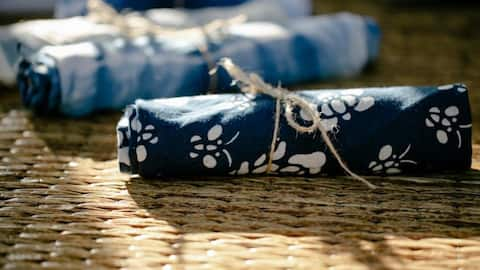Shibori: The ancient art of Japanese tie-dye
What's the story
Shibori is a traditional Japanese method of resist dyeing and creating intricate patterns on fabric. Dating back to the eighth century, the shibori-dyed cloth was silk, hemp, and later cotton. Indigo, being the predominant dye, was supplemented occasionally by madder and purple root. Shibori patterns often symbolize Japan's admiration for the beauty found in imperfection, a concept known as Wabi-sabi.
Principles
The essence of Shibori
Shibori, derived from "shiboru" (to wring or squeeze), focuses less on a specific technique and more on the dyeing process's interaction with the fabric. It emphasizes the methods of binding, stitching, folding, twisting, or compressing any fabric for shibori. The essence lies in harmoniously blending fabric characteristics, dye color, technique, and exposure duration to achieve the desired final product, reflecting the practitioner's vision.
History
Chinese origin
Shibori was introduced to Japan from China, but it didn't gain widespread popularity until the cultural and artistic upheavals of the Edo period. Historical records show that Emperor Shomu donated shibori-dyed items to one of Nara Prefecture's Seven Great Temples. Over time, new variations of the technique emerged, and other dyeing methods like tsutsugaki, which involves creating patterns using rice paste, also became prominent.
In culture
Everyday items
It can be found on various clothing items like kimono, yukata, and haori jackets, as well as on artworks displayed in museums like the Kyoto Shibori Museum in Japan and internationally recognized institutions such as the Rijksmuseum in Amsterdam. Shibori is used on everyday items like handkerchiefs, furoshiki (multi-purpose wrapping towels), pillowcases, and bags. Shibori techniques can be applied to any dyeable textile.
Major techniques
Three categories
Shibori in Japan categorizes into three main types: tied or bound resist, wax resist, and clamped resist, each with six major techniques. Kumo Shibori creates spider web-like designs by tying fabric sections. Miura Shibori produces ripple-like patterns using looping and binding. Kanoko Shibori, similar to Western tie-dye, utilizes elastic bands for tying fabric, providing beginners a customizable approach to shibori design.
Other Techniques
Intricate and bold
Nui Shibori stands out as the most intricate among shibori techniques, emphasizing both stitching and dyeing. This method intricately combines hand-stitching and wooden dowels for resistance, resulting in meticulously crafted designs and precise patterns. Tajime Shibori achieves bold patterns using wood or plastic clamps to resist dye, yielding thick, distinct shapes separated by vibrant color contrasts.
In home decor
Versatility
From throw pillows to curtains and table linens, shibori-dyed fabrics infuse homes with elegance and character. The versatility of shibori allows for customization, with various techniques creating mesmerizing spider web-like designs, or subtle ripple effects on your lenin and upholstery. Indigo-inspired wallpapers, tea coasters, and even dishes, though not dyed in the traditional sense, but influenced by shibori, can enhance any living space.
